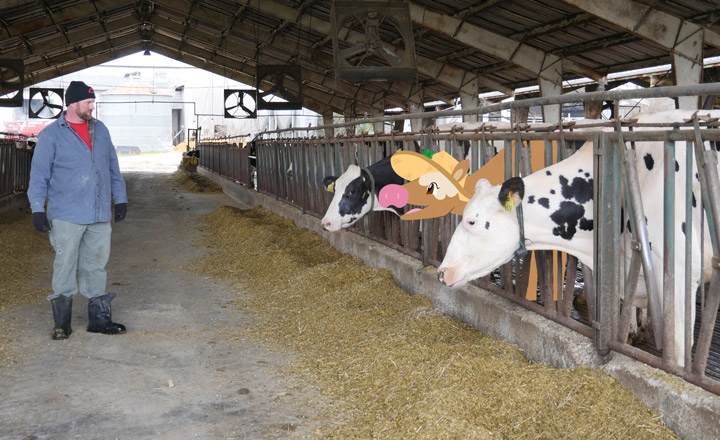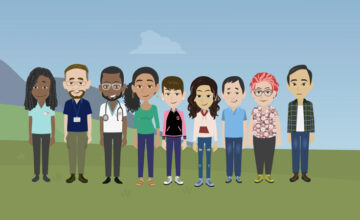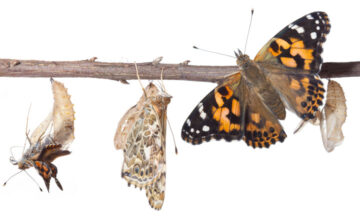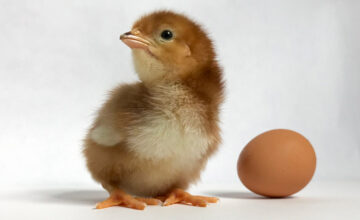
Curriculum Summary
4-H “Mooving Milk from Farm to Fridge” is a Cloverbud curriculum developed in partnership with the North Carolina State University Department of Animal Science, The Randleigh Dairy Heritage Museum, and The Dairy Alliance. In this unit, youth trace Clover the Cow’s growth from calf to dairy cow. Along the way, they learn about the dairy industry and how dairy foods can contribute to a healthy diet. The lessons in the unit feature dramatic roleplay, math, science, social studies, and literacy activities as well as
· Coloring pages to go with each lesson
· Take home activities so Cloverbuds can share their learning with caregivers
· Materials to reach a range of Cloverbud ages and skillsets to accompany each lesson
· A shared-reading book about milk safety
· Numerous suggestions for multimedia learning and extension activities
Age range: 5-7
Grade level: K-2
How Does a Calf Grow?
Youth act out a human life cycle. They compare the life cycle of a human to the life cycle of a dairy cow. Finally, they create pictograms to compare the weight of a human body to that of a cow at different stages in the life cycle of each. Virtual assets include:
- PDFs of all handouts
- Dairy Farm Tour Video
- Kahoot! link to review lesson
- Interactive Matching Game (coming soon!)
- Interactive Timeline (coming soon!)
NC Essential Standards
Kindergarten
Science K.L.1.2 Compare characteristics of living and nonliving things in terms of their:
- Structure
- Growth
- Changes
- Movement
- Basic needs
Math NC.K.CC.1 Know number names and recognize patterns in the counting sequence by counting to 100 by tens
NC.K.MD.2 Directly compare two objects with a measurable attribute in common, to see which object has “more of”/“less of” the attribute and describe the difference.
NC.K.G.1 Describe objects in the environment using names of shapes and describe the relative positions of objects using positional terms.
English/Language Arts RI.K.10 Actively engage in group reading activities with purpose and understanding.
SL.K.1 Participate in collaborative conversations with diverse partners about kindergarten topics and texts with peers and adults in small and larger groups.
- Follow agreed-upon rules for discussions.
- Continue a conversation through multiple exchanges.
Social Studies K.H.1.1 Explain how people change over time (self and others).
Art and Drama K.C.2.2 Use dramatic play to re-enact stories from texts read aloud.
K.C.1.1 Use a non-verbal expression to communicate movement elements.
First Grade
Science 1.L.2.2 Summarize the basic needs of a variety of different animals (including air, water, and food) for energy and growth.
Math NC.1.NBT.1 Count to 150, starting at any number less than 150.
NC.1.NBT.2 Understand that the two digits of a two-digit number represent amounts of tens and ones.
- Demonstrate that the numbers 10, 20, 30, 40, 50, 60, 70, 80, 90 refer to one, two, three, four, five, six, seven, eight, or nine tens, with 0 ones.
NC.1.MD.4 Organize, represent, and interpret data with up to three categories.
- Ask and answer questions about the total number of data points.
- Ask and answer questions about how many in each category.
- Ask and answer questions about how many more or less are in one category than in another.
English/Language Arts SL.1.1 Participate in collaborative conversations with diverse partners about grade 1 topics and texts with peers and adults in small and larger groups.
- Follow agreed-upon rules for discussions.
- Build on others’ talk in conversations by responding to the comments of others through multiple exchanges.
- Ask questions to clear up any confusion about the topics and texts under discussion.
Art/Drama 1.C.2.2 Use dramatic play to perform stories while texts are read aloud.
1.C.1.1 Use a non-verbal expression to communicate movement elements, including size, weight, and rate.
Second Grade
Science 2.L.1 Understand animal life cycles.
2.L.1.1 Summarize the life cycle of animals:
- Birth
- Developing into an adult
- Reproducing
- Aging and death
2.L.1.2 Compare life cycles of different animals such as, but not limited to, mealworms, ladybugs, crickets, guppies, or frogs.
Math NC.2.NBT.1 Understand that the three digits of a three-digit number represent amounts of hundreds, tens, and ones.
- Unitize by making a hundred from a collection of ten tens.
- Demonstrate that the numbers 100, 200, 300, 400, 500, 600, 700, 800, 900 refer to one, two,
- three, four, five, six, seven, eight, or nine hundreds, with 0 tens and 0 ones.
- Compose and decompose numbers using various groupings of hundreds, tens, and ones.
NC.2.NBT.2 Count within 1,000; skip-count by 5s, 10s, and 100s.
NC.2.NBT.3 Read and write numbers, within 1,000, using base-ten numerals, number names, and expanded form.
NC.2.MD.10 Organize, represent, and interpret data with up to four categories.
- Draw a picture graph and a bar graph with a single-unit scale to represent a data set.
English/Language Arts SL.2.1 Participate in collaborative conversations with diverse partners about grade 2 topics and texts with peers and adults in small and larger groups.
- Follow agreed-upon rules for discussions.
- Build on others’ talk in conversations by linking their comments to the remarks of others.
- Ask for clarification and further explanation as needed about the topics and texts under discussion.
Social Studies 2.H.1.1 Use timelines to show the sequencing of events.
What Does a Cow Eat?
Youth play a matching card game to learn about the different breeds of dairy cows and some of their food that are common in the United States. Youth also learn about the importance of a healthy diet for cows and humans. Virtual assets include:
- PDFs of all handouts
- Kahoot! link to a poll about favorite foods
- What’s In My Feed? a cartoon featuring Clover and the Farmer (coming soon!)
- Interactive Mem-MOO-ry Card Game (coming soon!)
- Make a Meal for Clover Interactive Game (coming soon!)
NC Essential Standards
Kindergarten
K.L.1.1 Compare different types of the same animal (i.e. different types of dogs, different types of cats, etc.) to determine individual differences within a particular type of animal.
K.L.1.2 Compare characteristics of living and nonliving things in terms of their:
- Structure
- Growth
- Changes
- Movement
- Basic needs
Healthful Living K.NPA.1 Understand MyPlate as a tool for selecting nutritious foods.
K.NPA.1.1 Classify foods by groups in MyPlate.
K.NPA.1.2 Recall foods and beverages beneficial to teeth and bones. K.NPA.2 Understand the importance of consuming a variety of nutrient-dense foods and beverages in moderation.
K.NPA.2.1 Recognize nutrient-dense foods in a list of foods that are culturally diverse.
K.NPA.2.2 Summarize the importance of a healthy breakfast and lunch.
First Grade
Science 1.L.1.1 Recognize that plants and animals need air, water, light (plants only), space, food and that these may be found in their environment.
Math NC.1.MD.4 Organize, represent, and interpret data with up to three categories.
- Ask and answer questions about the total number of data points.
- Ask and answer questions about how many in each category.
- Ask and answer questions about how many more or less are in one category than in another.
Healthful Living 1.NPA.1 Understand MyPlate as a tool for selecting nutritious foods.
1.NPA.1.1 Select a variety of foods based on MyPlate.
1.NPA.1.2 Contrast more nutrient-dense foods from those that are less nutrient-dense.
Second Grade
Math NC.2.MD.10 Organize, represent, and interpret data with up to four categories.
- Draw a picture graph and a bar graph with a single-unit scale to represent a data set.
- Solve simple put-together, take-apart, and compare problems using information presented in a picture and a bar graph.
Healthful Living 2.NPA.1 Understand MyPlate as a tool for selecting nutritious foods.
2.NPA.1.1 Recognize the interrelationship of parts of MyPlate.
2.NPA.1.2 Plan meals that are chosen for energy and health.
2.NPA.2 Understand the importance of consuming a variety of nutrient-dense foods and beverages in moderation.
Third Grade
Healthful Living 3.NPA.1 Apply tools (MyPlate, Food Facts Label) to plan healthy nutrition and fitness.
3.NPA.1.1 Use MyPlate to eat a nutritious breakfast each morning.
3.NPA.2 Understand the importance of consuming a variety of nutrient-dense foods and beverages in moderation.
3.NPA.2.1 Identify the sources of a variety of foods.
How Does a Cow Make Milk?
Youth learn about the steps of digestion for the human body. Then they role play as pieces of food to learn about the steps of digestion in a ruminant system. Virtual assets include:
- PDFs of all handouts
- Video of Cattle Nutrition and Digestion
- Interactive diagram of human and cow digestive systems (coming soon!)
NC Essential Standards
Kindergarten
Science K.L.1.2 Compare characteristics of living and nonliving things in terms of their:
- Structure
- Growth
- Changes
- Movement
- Basic needs
Math NC.K.MD.1 Describe measurable attributes of objects and describe several different measurable attributes of a single object.
NC.K.MD.2 Directly compare two objects with a measurable attribute in common, to see which object has “more of”/“less of” the attribute and describe the difference.
NC.K.MD.3 Classify objects into given categories; count the numbers of objects in each category and sort the categories by count.
English/Language Arts RI.K.4 With prompting and support, ask and answer questions about words in a text.
RI.K.10 Actively engage in group reading activities with purpose and understanding.
Art/Drama K.C.2.2 Use dramatic play to re-enact stories from texts read aloud.
K.C.1.1 Use a non-verbal expression to communicate movement elements.
First Grade
Science 1.L.2.2 Summarize the basic needs of a variety of different animals (including air, water, and food) for energy and growth.
Math NC.1.MD.4 Organize, represent, and interpret data with up to three categories. ]Ask and answer questions about the total number of data points.
- Ask and answer questions about how many in each category.
- Ask and answer questions about how many more or less are in one category than in another.
English/Language Arts RI.1.4 Ask and answer questions to help determine or clarify the meaning of words and phrases in a text.
RI.1.10 With prompting and support, read and understand informational texts appropriately complex for grade 1 for sustained periods of time.
Art/Drama 1.C.2.2 Use dramatic play to perform stories while texts are read aloud.
1.C.1.1 Use a non-verbal expression to communicate movement elements, including size, weight, and rate.
Second Grade
Math NC.2.MD.10 Organize, represent, and interpret data with up to four categories.
- Draw a picture graph and a bar graph with a single-unit scale to represent a data set.
- Solve simple put-together, take-apart, and compare problems using information presented in a picture and a bar graph.
English/Language Arts RI.2.3 Describe the connection between a series of historical events, scientific ideas or concepts, or steps in technical procedures in a text.
RI.2.4 Determine the meaning of words and phrases in a text relevant to a grade 2 topic or subject area.
RI.2.10 By the end of grade 2, read and understand informational texts within the 2-3 text complexity band proficiently and independently for sustained periods of time. Connect prior knowledge and experiences to the text.
Third Grade
English/Language Arts RI.3.3 Describe the relationship between a series of historical events, scientific ideas or concepts, or steps in technical procedures in a text, using language that pertains to time, sequence, and cause/effect.
RI.3.4 Determine the meaning of general academic and domain-specific words and phrases in a text relevant to a grade 3 topic or subject area.
RI.3.10 By the end of grade 3, read and understand informational texts at the high end of the 2-3 text complexity band proficiently and independently for sustained periods of time. Connect prior knowledge and experiences to the text.
How Does Milk Get From the Farm to the Store?
Youth build mini-coolers to learn about insulation and food safety. They also read a picture book about food safety for dairy products. Virtual assets include:
- PDFs of all handouts
- Keepin’ Cool! video
- E-book version of the picture book (coming soon!)
- Temperature Control Game (coming soon!)
NC Essential Standards in Science
First Grade
Healthful Living 1.PCH.1 Apply measures for cleanliness and disease prevention.
1.PCH.1.1 Recognize that germs produce illness and can be spread from one person to another.
1.PCH.1.2 Use measures for preventing the spread of germs.
Second Grade
Science 2.P.2.1 Give examples of matter that change from a solid to a liquid and from a liquid to a solid by heating and cooling.
Third Grade
Science 3.P.2.1 Recognize that air is a substance that surrounds us, takes up space, and has mass.
3.P.2.2 Compare solids, liquids, and gases based on their basic properties.
3.P.2.3 Summarize changes that occur to the observable properties of materials when different degrees of heat is applied to them, such as melting ice or ice cream, boiling water or an egg, or freezing water.
3.P.3.2 Recognize that energy can be transferred from a warmer object to a cooler one by contact or at a distance and the cooler object gets warmer.
How Can We Process Dairy?
Youth process milk into butter and taste different types of cheeses. Virtual assets include:
- PDFs of all handouts
- Cheese tasting video
NC Essential Standards
Kindergarten
Science K.P.2 Understand how objects are described based on their physical properties and how they are used.
K.P.2.1 Classifies objects by observable physical properties (including size, color, shape, texture, weight, and flexibility).
English/Language Arts W.K.1 Use a combination of drawing, dictating, and writing to compose opinion pieces in which they tell a reader the topic or the name of the book they are writing about and state an opinion or preference about the topic or book.
- With guidance and support from adults, respond to questions and suggestions from adults and/or peers and add details to strengthen writing as needed.
Social Studies K.E.1.2 Explain how jobs help people meet their needs and wants.
Healthful Living K.PCH.1.1 Use steps of correct handwashing at appropriate times throughout the day.
First Grade
English/Language Arts W.1.1 Write opinion pieces in which they introduce the topic or name the book they are writing about, state an opinion, supply a reason for the opinion and provide closure.
- With guidance and support from adults, focus on a topic, respond to questions and suggestions from peers, and add details to strengthen writing as needed.
Social Studies 1.E.1.1 Summarize the various ways in which people earn and use the money for goods and services.
1.E.1.2 Identify examples of goods and services in the home, school, and community.
Healthful Living 1.PCH.1 Apply measures for cleanliness and disease prevention.
1.PCH.1.1 Recognize that germs produce illness and can be spread from one person to another.
1.PCH.1.2 Use measures for preventing the spread of germs.
Second Grade
Science 2.P.2.1 Give examples of matter that change from a solid to a liquid and from a liquid to a solid by heating and cooling.
English/Language Arts W.2.1 Write opinion pieces in which they introduce the topic or book they are writing about, state an opinion, supply reasons that support the opinion, use linking words to connect opinion and reasons, and provide
- a concluding statement or section.
- with guidance and support from adults and peers, focus on a topic, and strengthen writing as needed by revising and editing.
Social Studies 2.E.1.1 Give examples of ways in which businesses in the community meet the needs and wants of consumers.
2.E.1.2 Explain the roles and impact producers and consumers have on the economy.
Healthful Living 2.PCH.2.1 Summarize reasons and strategies for preventing contact with body fluids.
Third Grade
Science 3.P.2.2 Compare solids, liquids, and gases based on their basic properties.
English/Language Arts W.3.1 Write opinion pieces on topics or texts, supporting a point of view with reasons organizational structure that lists reasons.
- Introduce the topic or text they are writing about, state an opinion, and create an organizational structure that lists reasons.
- Provide reasons that support the opinion.
- With guidance and support from peers and adults, develop and strengthen writing as needed by revising and editing, with consideration to task and purpose.
Social Studies 3.E.2.1 Explain why people become entrepreneurs.
3.E.2.2 Give examples of entrepreneurship in various regions of our state.
Why Should You Drink Milk?
Youth conduct an experiment to model the effects of different beverages on their teeth so they can make healthy beverage choices. They also compare the nutrients found in four common beverage options. Virtual assets include:
- PDFs of all handouts
- Interactive experiment (coming soon!)
- Interactive puzzle (coming soon!)
NC Essential Standards
Kindergarten
Healthful Living K.NPA.1.2 Recall foods and beverages beneficial to teeth and bones.
K.NPA.2 Understand the importance of consuming a variety of nutrient-dense foods and beverages in moderation.
First Grade
Healthful Living 1.NPA.1.2 Contrast more nutrient-dense foods from those that are less nutrient-dense.
Second Grade
Healthful Living 2.NPA.1.2 Plan meals that are chosen for energy and health.
2.NPA.2 Understand the importance of consuming a variety of nutrient-dense foods and beverages in moderation.
Third Grade
Healthful Living 3.NPA.1 Apply tools (MyPlate, Food Facts Label) to plan healthy nutrition and fitness.
3.NPA.2 Understand the importance of consuming a variety of nutrient-dense foods and beverages in moderation.
3.NPA.2.2 Categorize beverages that are more nutrient-dense.




